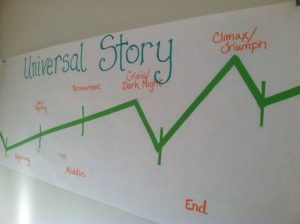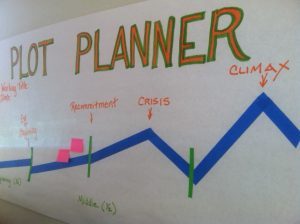Excellent advice from Martha Alderson
Requests for plot and transformational consultations are streaming in from around the world with people’s’ fervent expressions. This is the year I’m passionate to finish my novel. I promise to change. I’m hell-bent (determined to achieve something at all costs) to succeed. Before you begin any resolution, first plot a plan. Following are 7 steps how to plot your novel and your personal goals whether they be to:
- meet a writing deadline
- plot a publishing strategy
- create something new
- break a destructive habit
- plot your personal transformation
I recommend using a Plot Planner for any plan you intend to undertake. The planner is a visual template patterned after the Universal Story which leads to all creativity, transformation, and success. The Universal Story is the story of life.
First view the simple line as the literal expression you’re looking at. See how the line travels upward, then drops down, builds again to the highest peak, and ends with one final drop. The line of the Universal Story, with no true beginning or end, continues on.
 Now, feel in your body / your heart what the line represents energetically — an intrinsic rhythm that runs through stories and pours throughout all life – in the ebb and flow of the tides, the moon, the seasons, and our lives. This rhythm supports us all. We each move to the flow in our own unique ways.
Now, feel in your body / your heart what the line represents energetically — an intrinsic rhythm that runs through stories and pours throughout all life – in the ebb and flow of the tides, the moon, the seasons, and our lives. This rhythm supports us all. We each move to the flow in our own unique ways.
Think of the line as a huge canvas like waves traveling across a vast ocean. Motion and challenges rest in the sea. Breaking waves, sneaker waves, rip currents, wind gusts, and hurricanes strike above the water line. Below the sea is silence and calm.
Universal Story
The energy of the Universal Story is divided into three phases that correspond to the cyclical paradigm sweeping through every story and throughout every endeavor we undertake:
- Comfort and Separation
- Resistance and Struggle
- Transformation and Return
7 Steps How to Plot Your Novel and Your Personal Goals
1.Draw a Plot Planner line for your story (or whatever venture you’re ready to undertake)
2. For your story, consider how the character changes and transforms by all she does and all that happens to her throughout the story. What will she do at the end of the story to symbolize facing her greatest fear and prevailing? Write that above the highest peak toward the  end of the Plot Planner line. If there is a time limit in which she must meet her goal, also include that. (If you’re plotting a personal plan, put the date you wish you accomplish your task above the highest peak)
end of the Plot Planner line. If there is a time limit in which she must meet her goal, also include that. (If you’re plotting a personal plan, put the date you wish you accomplish your task above the highest peak)
3. Jot down both the light and shadow traits the character embodies before the story begins. Arrange these notations well above the beginning of the Plot Planner line. Leave room both above and below the line for notes about the specific actions she’ll take. Create aspects of her characterization that differ as much as possible from who she becomes at the end, which then leaves room for a satisfying character change and transformation (Personal Plot – write down the personal character traits you believe will most interfere with your success. Also include those traits that will most support your success — both your light and shadow traits — at the beginning of the Plot Planner).
4. In the same place at the beginning of the Plot Planner: 1) write the character’s long-term goal, what she’ll strive toward throughout the story (make her goal concrete and measurable), 2) what motivates her to take action even against all odds, 3) what she stands to lose if not successful. (Personal Plot – Do the same exercise for your own personal plot: 1) note the specific, concrete goal you wish to achieve, 2) your motivation, 3) what you stand to lose if not successful).
5. Working backwards from the end, consider the major actions that will take place in the beginning, middle, and end of your story. Write the steps your character must take to achieve her goal. Place these in the appropriate place along the Plot Planner line. Indicate skills and abilities and lessons she must learn in the middle to prevail at the end. Specify who and what will teach her these things. (For your personal plot, show the number of words you’ll need to write daily to achieve your writing goal deadline. Or, designate whatever types of activities you’ll do to achieve whatever your goal in the appropriate place along the Plot Planner Line).
6. Determine what antagonists to introduce that will most interfere with those actions you plotted for your protagonist. Put the challenges and conflicts they impose on the protagonist where they’ll appear in the beginning, middle, and end. (Personal Plot – Consider your life situation and who or what will most interfere with your success. Mark above the Plot Planner where you believe these interferences are most likely to strike. Strategize how best to negotiate around both your own internal self-sabotaging behaviours and beliefs, and those around you. Include your strategies below the Plot Planner line.
7. Based on the antagonists you dream up in Step #6, consider the most dramatic and thematically true conflict that will arise around the 3/4 mark toward the end of the middle of your story. Make notes above that first peak that represents the character’s dark night, crisis, or breakdown that leads to her ultimate break-through.
Personal Plot – In every endeavour there comes a time when you hit a wall and believe you’ve failed. This perceived failure happens either through no fault of your own or because of self-sabotaging habits and belief. This sense of all is lost usually hits when you’re about three quarters of the way through your work. You’ve heard the expressions:
- “The darkest hour is just before dawn.”
- “Things often seem at their worst just before they get better.”
- Characters in a story must find a way to rise above the conflict and continue on her journey to seize fulfilment at the end. Not so in real life. The downward line after the first peak on the Plot Planner indicates a sort of limbo that people often become mired in.
- Feeling faced with odds we believe we are not strong enough, good enough or worthy enough to overcome, we fall into an abyss. Feeling sorry for ourselves, believing we can’t do it or be successful, we become victims rather than victors.
- This is the most critical time on your way to success. A place you must anticipate and encourage yourself through. Otherwise, you may become stuck in negative self-talk. Sometimes for a lifetime…
Anticipation of What’s to Come
Having followed the 7 Steps How to Plot Your Novel and Your Personal Goals, you’ve anticipated what you can of your protagonist’s journey and/or your own journey. Now, step back from the Plot Planner you created. Understand that this is a universal template. Both you and your protagonist will be challenged along the way to success and forced to recommit to your goals many times. Your dedication is especially required in the middle and the nearer you come to the end.
Both you and your protagonist will suffer setbacks on the way to your goals. No matter how challenging or traumatic, so long as you pick yourself up and continue, every setback offers the ultimate gift of learning, growth, and transformation.


